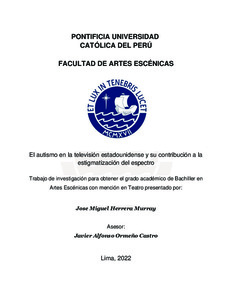| dc.contributor.advisor | Ormeño Castro, Javier Alfonso | |
| dc.contributor.author | Herrera Murray, Jose Miguel | |
| dc.date.accessioned | 2023-11-02T20:51:18Z | |
| dc.date.available | 2023-11-02T20:51:18Z | |
| dc.date.created | 2022 | |
| dc.date.issued | 2023-11-02 | |
| dc.identifier.uri | http://hdl.handle.net/20.500.12404/26342 | |
| dc.description.abstract | La investigación busca analizar la manera en la que la representación de personajes autistas en
la mayoría de programas de televisión estadounidenses de las últimas décadas ha representado una
influencia para la proliferación de los estigmas presentes en el imaginario colectivo respecto al
espectro autista. Para este propósito, el presente trabajo estudia dichas representaciones en base a
diferentes ejemplos dentro de estas series y los relaciona con los estigmas más comunes y
difundidos sobre las personas autistas, para así establecer un vínculo entre ambos y proponer los
motivos por los cuales estas representaciones tienden a contribuir a la estigmatización del autismo
en lugar de desafiarla.
Los motivos que surgen de este estudio para la existencia de esta tendencia serían,
principalmente, la interpretación de personajes autistas por parte de actores neurotípicos en roles
que presentan un número limitado y ambiguo de características físicas e intelectuales, así como la
predominancia de series en las que se impulsa una narrativa que valora a las personas autistas en
base a su funcionalidad social y sus capacidades intelectuales. El estudio ahonda sobre estos
motivos localizando su justificación en factores como la falta de representación y participación de
la comunidad autista en la realización de estos programas, los orígenes eugenésicos de la teoría
sobre autismo, el “falso equilibrio” en las representaciones con un enfoque médico como base
principal, y la predominancia de representaciones negativas e hiperpositivas. | es_ES |
| dc.description.abstract | This research analyzes how the representation of autistic characters in most American
television programs in recent decades has supported the proliferation of stigmas present in the
collective imagination regarding autism. For this purpose, different characters within these shows
will be studied based on their representation and the stigmas they relate to. This will allow to
establish a link between the two and question why these shows tend to contribute to the
stigmatization of autism instead of challenging it.
There are many different reasons for this: First, the trend of neurotypical actors portraying
autistic characters which neurotypical writers also write. Second, the limited amount of physical
and intellectual characteristics that said characters seem to have, which limits the audience’s
understanding of the diversity within autistic people. Lastly, the predominance of shows that
promote the appreciation of autistic people based solely on their intelligence and social skills. The
justification for all of these reasons can be found in certain factors around said shows, mainly the
lack of representation and participation of the autistic community present in their making. Other
aspects that push for stigmatization in television are, just as well, the eugenic origins of autism
theory that still influence common knowledge about the spectrum, the "false balance" in
representations with a medical approach as the main basis, and the predominance of negative and
hyper positive representations. | es_ES |
| dc.language.iso | spa | es_ES |
| dc.publisher | Pontificia Universidad Católica del Perú | es_ES |
| dc.rights | info:eu-repo/semantics/openAccess | es_ES |
| dc.rights.uri | http://creativecommons.org/licenses/by-sa/2.5/pe/ | * |
| dc.subject | Autismo en la televisión--Estados Unidos | es_ES |
| dc.subject | Autismo en la televisión--Aspectos sociales | es_ES |
| dc.subject | Estigmatización | es_ES |
| dc.title | El autismo en la televisión estadounidense y su contribución a la estigmatización del espectro | es_ES |
| dc.type | info:eu-repo/semantics/bachelorThesis | es_ES |
| thesis.degree.name | Bachiller en Artes Escénicas con mención en Teatro | es_ES |
| thesis.degree.level | Bachillerato | es_ES |
| thesis.degree.grantor | Pontificia Universidad Católica del Perú. Facultad de Artes Escénicas | es_ES |
| thesis.degree.discipline | Artes Escénicas con mención en Teatro | es_ES |
| renati.advisor.dni | 07643768 | |
| renati.advisor.orcid | https://orcid.org/0000-0001-7415-0130 | es_ES |
| renati.author.dni | 73127586 | |
| renati.discipline | 215586 | es_ES |
| renati.level | https://purl.org/pe-repo/renati/level#bachiller | es_ES |
| renati.type | https://purl.org/pe-repo/renati/type#trabajoDeInvestigacion | es_ES |
| dc.publisher.country | PE | es_ES |
| dc.subject.ocde | https://purl.org/pe-repo/ocde/ford#6.04.04 | es_ES |






